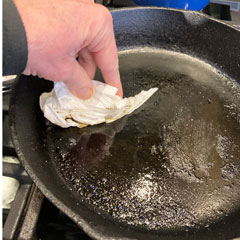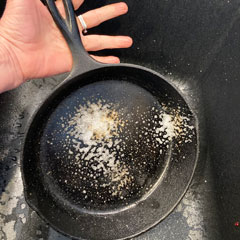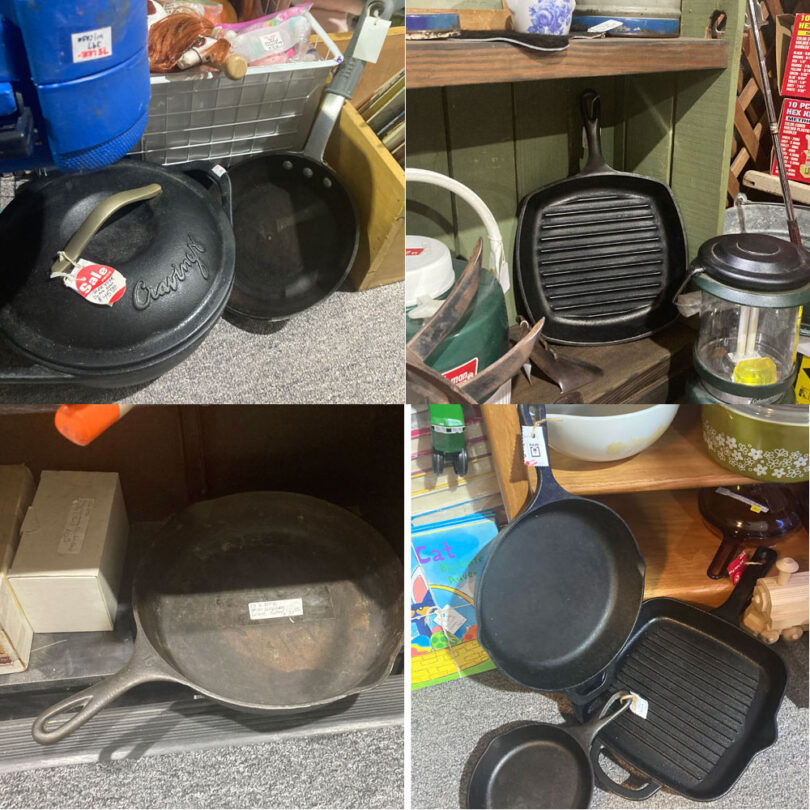Cast iron skillets have many benefits, including their durability, versatility, and natural non-stick properties. They are an absolute favorite in the Buy It For Life (#bifl) community. My personal cast iron skillet, featured in the pictures accompanying this article was already old when I bought it many years ago at an outdoor flea market in Iowa. I would guess that it was easily 30 years old when I bought it, and now it 35 years older. This is truly an item that gets better with age.
Benefits of Cast Iron Cookware
Whether you have a cast iron skillet, a cast iron grilling pan or a cast iron dutch oven (large cooking pot with a lid), you can expect these benefits:
Durability
- Cast iron is dense and can withstand damage. Pans can get dropped without any damage to themselves, but watch out for your toes! They might dent your floor, though, so try to avoid this.
- Cast iron skillets are long-lasting and often are a one-time investment.
- Cast iron doesn’t scratch, so you can use metal spatulas or other cooking tools without worry.
Versatility
- Cast iron skillets can be used on the stovetop, in the oven, or over an open flame.
- Cast iron can be used for frying, sautéing, baking, and even for grilling.
- Available in a wide range of sizes and configurations: I’ve seen skillet shapes as small as for cooking one egg. I have a stove top flat grille that is terrific for cooking pancakes.
- Cast iron can be used for serving and keeping food warm. Favorite sizes for this purpose are small skillets that hold one serving: you can take them straight out of the oven and set them on a potholder at the dinner table. Small flat skillets, often in an oval shape are great for serving food like fajitas.
One thing that I would not use Cast Iron Skillets for would be boiling or poaching because that can remove the “seasoning”. In particular, acidic sauces like marinara or other tomato based foods, or sauces with a lot of citrus can be tough on the seasoned surface of the pan.
Heat Retention
- Cast iron skillets retain heat well, which helps keep food hot.
- Cast iron skillets promote even cooking all across the pan surface, not just in the center of the pan closest to the flame or burner element.
- Cast iron’s even heating helps meats brown and vegetables cook faster.
Cast iron tolerates very high temperatures with ease, so as long as you have proper ventilation and a flame-resistant cooking arrangement, you can use cooking techniques such as blackening or “flashing” the skillet.
Non-Stick
Cast iron skillets develop a natural non-stick coating when seasoned and cared for properly. The “seasoning” or naturally developed coating is a result of polymerization of the vegetable oils and animal fats used when cooking.
This coating reduces the amount of oil or butter that you need to use, which can make food lower in fat.
Easy to Clean
- Cast iron skillets are easy to clean and maintain once they are properly seasoned.
- Cast Iron actually benefits from not being cleaned extensively – see my comments below.
Natural Product
- Cast iron skillets are made from natural material.
- Some of the iron from the pan can absorb into food, which may have health benefits for some people. See my experience below.
Affordable
Cast iron skillets are often affordable and can be found at thrift stores or estate sales.
Buying a new iron skillet is not a big investment, especially considering that you’ll never have to replace it. We recommend buying a pre-loved skillet if you can find one, but if you can’t, see the next section on how to season your pan.
What’s my favorite food to cook in cast iron skillet: hash browns! They get so much browner and crispier than any other cooking method I’ve tried.
How to Season Cast Iron Cookware
These instructions work for any kind of Cast Iron cooking surfaces.
New Cookware
- Check the manufacturers instructions – sometimes they put wax or shellac on cookware to prevent rusting while shipping, and this coating needs to be burned off first. The skillets I list at the bottom of this article are pre-seasoned, so you won’t need to do this step.
- Pre-heat your oven to 450 degrees Farenheit (about 235 Celsius).
- Coat both the inside and the outside of the pot with a thin, uniform coat of unsaturated oil, such as Canola oil or Soybean oil.
- Wipe as much of the oil off of the pot as possible. You should have a very thin, slightly oily sheen all over the pot.
- Stick the pot in the oven and let it heat for 20 minutes.
- Turn the oven off. You can just leave the pot in the oven to cool completely.
- Repeat at least once. Repeating this process multiple times increased the thickness and durability of the seasoned coating.
Try cooking something in your seasoned pot. If things still stick, you can repeat the seasoning process, or just cook more stuff and avoid cleaning the pot too much. See my comments in the cleaning section of this article.
Used Cookware
Since you don’t know what kind of oils were used originally season a pan, some people like to burn off the old seasoning by first scrubbing the pan aggressively, then heating the pan in their self-cleaning oven at high temperatures. Be sure to have very good ventilation in your house if you choose this method.
Frankly, I’ve bought a number of used Cast Iron items over time, and I have never worried about it. I’ve never gotten sick, never had any odd odors, and never had the existing seasoning surface affected by this method:
- Pre-heat your oven to 450 degrees Farenheit (about 235 Celsius).
- Gently scrub the pan, inside and out with warm water and a bit of Dawn Dish Detergent to remove any debris or grease. If there are sticky patches, sometimes adding some used coffee grounds to the detergent can add scrubbing power.
- If there is any rust, you can scrub at it too, if the appearance bothers you. The seasoning process will work to seal any rust.
- Coat both the inside and the outside of the pot with a thin, uniform coat of unsaturated oil, such as Canola oil or Soybean oil.
- Wipe as much of the oil off of the pot as possible. You should have a very thin, slightly oily sheen all over the pot.
- Stick the pot in the oven and let it heat for 20 minutes.
- Turn the oven off. You can just leave the pot in the oven to cool completely.
Depending on the condition of your used pan, you can choose to repeat this process, but I have never needed to. Start cooking! You will find out soon whether you have a good non-stick surface or whether you might want to season again.
Cleaning and Maintenance of your Cast Iron Skillet
The beauty of Cast Iron, is that the less you do, the better your skillet will perform for you.
Consider that the main reason you clean pots and dishes to avoid germs. The cooking temperatures used with a Cast Iron Skillet also kill micro-organisms on the skillet and in the food being cooked. You don’t want to remove that seasoning that you worked so hard to achieve, so I think the best thing you can do for your skillet is to leave it alone.
Do This

After your skillet cools, scrape out any remaining food residue
Wipe out excess oil with a paper towel or kitchen sponge
Leave the skillet with a thin film of oil in it until you are ready to use the skillet again. Really, you don’t need to wash it. Any residual oil or spices are probably going to be just fine with whatever you cook next. The heat of the cooking makes this method safe.
If the spices that you used previously might affect the flavor of the food you cook next, gently clean the skillet with warm water and a spritz or two of Dawn Powerwash. Don’t scrub hard – just clean it enough to remove flavors.

If you have areas on the outside of the pot that seem more rusty than you like, rub in some more unsaturated oil just like you did in the seasoning process. Sometimes I get some sticky buildup in the corners of the flat grille that I use for cooking pancakes – I just shave this off using a razor blade. It does not hurt the Cast Iron or the seasoning layer underneath.
Don’t Do This
- Don’t wash your Cast Iron pots in the Dishwasher!
- Don’t put Cast Iron pots in the sink, fill them with water, then leave them to sit overnight or longer with water in them!
- If you feel that you must scrub your Cast Iron after every use, don’t let the pot sit in a puddle. Dry the excess water from it, or at least put it in a draining rack so that it can throughly air dry and not rust.
Cast Iron Cooking for Health
There are two main reasons that I view cooking in a Cast Iron Skillet as a healthy move for me:
#1 – I use very little extra oil when cooking. I usually use less oil than recommended in recipes or package instructions. Even so, food rarely sticks to my Cast Iron pan. Instead of pouring Canola Oil into my pan, for example, I use oil in a spray can instead. For certain foods that don’t tend to stick, I just put a couple tablespoons of water in the pan instead of oil.
#2 – Cast Iron cooking provides tiny amounts of Iron supplementation to my diet. When I was young, my mother hated Cast Iron of any kind. I think it reminded her of the Depression or something. She wanted brand new pans with non-stick coatings: Teflon! Ish – now we know better.
As a kid, I had anemia due to a lack of iron sources in my diet. My doctor had me take Iron supplements for years. Once I started eating food that was mostly cooked in Cast Iron cookware, the levels of Iron in my blood started rebounding. I have not needed to take supplements now for 35 years and my Iron levels are right in the middle of the recommended range. I would caution anyone that has a fairly rare condition called hemochromatosis (an excess of iron in the blood) to avoid Cast Iron cookware.
Top Places to Buy a Cast Iron Skillet
Cast Iron cookware is one of those things where there is a huge advantage to buying an old, pre-used item. Used Cast Iron is often already seasoned, so you can quickly obtain the non-stick behavior that is so sought after. The research that I’ve done makes it clear that this type of cookware is MORE expensive to buy used, than to by it new.
I got my skillet at an outdoor flea market – but since there aren’t a lot of those available, here is where I would look if I needed a skillet:
- An Antique Store – especially the Antique Marketplace kind of store where there are a bunch of individual vendors with booths or displays within a larger store. I got the pictures of all the pots and skillets in the featured image for this article at my local Antique Indoor Flea Market. A tour through the market turned up over a dozen choices – my picture above shows just some of the variety.
- Estate Sales – This is a really good way to get pre-loved Cast Iron, because the pans you find in someone’s kitchen usually have been well cared for. I’ve also seen a few sales where the home has a display on the wall of many unusual shapes and sizes of iron cookware.
- A Thrift Store – Cast Iron cookware does sometimes get donated. I’ve volunteered at a nice shop for about 8 years, and in that time I’ve seen four or five pans come through. If you do see a Thrift Store opportunity, don’t wait! Good skillets get snapped up right away.
- Online marketplaces (EBay, Craigslist, Facebook Marketplace, Nextdoor, etc.) – you can sometimes find Cast Iron cookware through this method. My experience is that the prices tend to be really inflated, though.
If you just don’t have the time to “search the thrift store jungles”, and you’d like to have a Cast Iron Skillet right now, here are a couple online selections for brand new pans. Many of the new pans listed online are now sold as ‘pre-seasoned’, but expect that you may need to do some additional work to get the pan just the way you want. Follow the seasoning and cleaning guidance in this article and eventually you’ll have a seasoned pan that is your go-to for most of things you cook.
This skillet from Lodge is the classic shape, with an added small handle opposite the handle to better grip the pan when hot or full of food. You also get a silicone sleeve to slip over the handle when it is hot. The skillet has been treated to be 'pre-seasoned'.
When cooking for a family, this skillet is a good size for cooking a lot of food.
This Lodge skillet is the same size as the one I show in all my pictures. It is a perfect size when cooking for one or two people. It is also lighter than the 12" model, which I like. This model comes with the extra assistive handle opposite the larger handle, which is a feature I wish my own skillet had. If you follow the link, the page also has a bunch of other sizes listed as options, including sets with graduated sizes of skillets.
Table of Contents
For those of you interested in kitchen and culinary related articles, here are some ideas:
- Maldon Salt – Why You Should Flake Out! – Learn about the “best ever” finishing salt in my kitchen.
- Wooden Cutting Boards – So Much Safer than Plastic! The “urban legend” that wood is unhygienic is just not supported by the scientific evidence.










